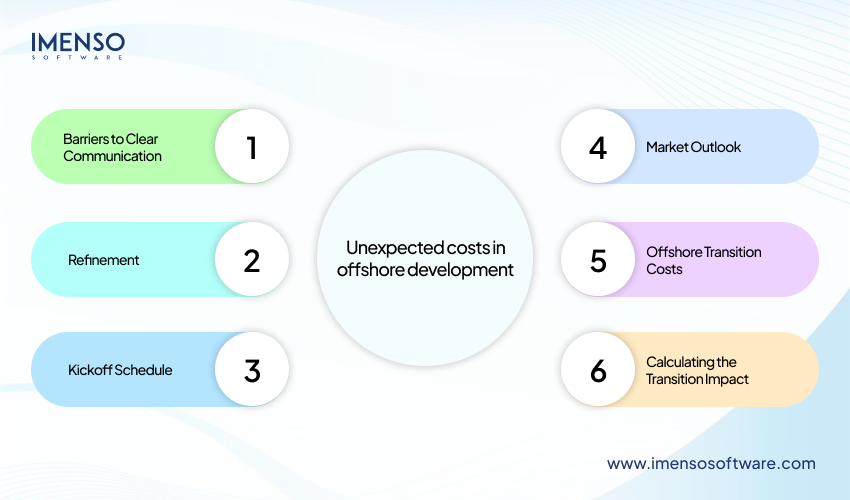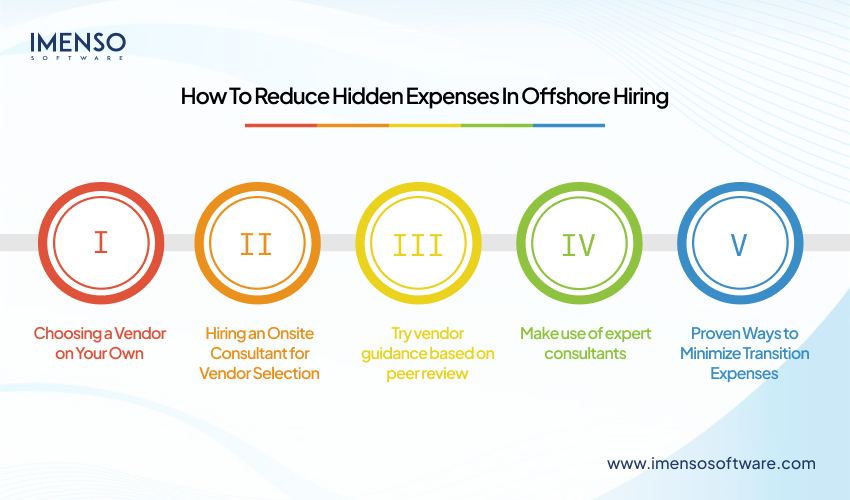The Hidden Costs of Hiring Developers Offshore (And How to Avoid Them)

Are you exploring ways to reduce offshore development costs by hiring developers from overseas? The debate around outsourcing has been ongoing in the U.S. for years—and it’s not going away anytime soon.
Still, one fact remains clear: businesses often need an offshore development team because it significantly cuts expenses. Partnering with skilled developers from other countries offers an affordable and efficient way to build high-quality software without compromising on results.
For more than twenty years, American companies have hired software program developers from nations like India and Eastern Europe. The answer is simple: hiring a developer inside the U.S. can cost around $100 per hour.
But in places like India, it may only cost $20 a step per hour. This price difference makes outsourcing a famous choice for many companies. The fee difference is brilliant, making offshore hiring a tempting alternative.
But there’s more to the story than just the cost per hour. Hidden expenses can quickly add up, making offshore development costs more than it initially seems.
What You Need to Know Before Hiring Offshore Developers
Offshore outsourcing may seem like a good way to save money on software development because of lower rates. However, there can be hidden costs that surprise you and turn your savings into extra expenses. Read our blog on checklist for hiring offshore developers here!
In this blog, we’ll interpret the hidden outsourcing expenses of hiring developers and how to avoid them. Whether you’re a startup or a longtime business, expertise outsourcing fees are essential. This expertise will help you make clever outsourcing options.
What Is Offshore Software Development?
Offshore software development involves hiring developers from other countries. This practice helps with tech projects. Businesses do this because it’s cheaper than hiring developers in their own country. Some popular countries for offshore work are South America, Poland, and India, where there are many skilled workers.
Companies prefer to work with developers who speak good English. This makes communication easier. This helps teams work together. These teams can work on projects. They can also work on app development, web design, and quality checking.
Unexpected Costs in Offshore Development

At first, outsourcing looks like an outstanding idea because it can save money on production. Businesses think they can be aware of developing the corporation without spending too much. But, many companies realize that outsourcing can cause problems like mistakes and confusion.
These issues lead to extra costs that weren’t planned for, making it not so cheap. In the end, businesses may fail their reputation, which can hurt their achievement. It’s essential to think closely before selecting outsourcing.
Offshoring can be compelling, but it comes with hidden costs that must be considered ahead of time. Here are those four hidden outsourcing expenses.
Barriers to Clear Communication
Software development initiatives require effective and transparent communication. Despite their best efforts, near and offshore teams frequently struggle. This is because of time zone variations, sporadic language difficulties, and a lack of a common cultural backdrop. These difficulties may appear in a number of ways:
- Communication delays due to time zone variations hinder productivity. These delays also lead to postponed decision-making.
- Offshore teams often struggle to understand the business context and project goals. This can result in outputs that are not aligned.
- Agile development techniques are essential for producing novel products. However, the lack of real-time, iterative contact hinders their effectiveness.
- Missed chances to enhance product functionality and user experience can result from a lack of awareness of end-user demands. This lack of awareness can also be attributed to a disconnect between business culture and user needs.
Refinement
One of the biggest hidden offshore development costs is the need for rework. Poor verbal exchanges can cause misunderstandings. Misunderstandings can result in a very last product, not assembly expectations. This means more work needs to be done, which takes extra time and money.
When rework happens, it can slow down projects and make budgets tighter. It also pushes back deadlines, which can be frustrating for everyone involved. Clear communication from the start can help avoid these problems.
- Reworking a software project can cost a lot of money, even up to 70% of the total budget. This happens when changes need to be made after the work has started. It’s important to plan carefully from the beginning to avoid these budgeting mistakes.
- Offshore development can cause extra problems that need more management and quality checks. These extra tasks are often not included in the original project plans or budgets.
- Frequent changes can make it harder for people to work well together. This can lower morale and affect how much the team gets done.
- When products take longer to release because of extra work, it can cause problems. This delay may lead to missing out on chances in the market and falling behind competitors.
Kickoff Schedule
It is a common misperception that going offshore will save you money right away. In actuality, there is a substantial ramp-up phase with associated offshore development costs. The time it takes for a new developer to learn about and participate in a project is known as the ramp-up phase.
This prolonged onboarding process can cause project schedule delays. It can also cause beginning cost inflation.
- Initial deadlines are frequently extended. Offshore teams need more time for project scoping, requirements defining, and knowledge transfer.
- Offshore teams have high turnover rates (typically more than 20% per quarter). This leads businesses must continually retrain new engineers. They can lose important project expertise in the process.
- The ramp-up stage is prolonged. This is due to the need for more time and resources to synchronize working styles and overcome cultural barriers.
Market Outlook
The real kicker comes next. You could pass up a chance to invest in the future of your business when you make an overseas investment. Offshore teams do not reinvest their knowledge and skills back into your organization. Consultative partners, however, do.
Nearshore and offshore developers are usually viewed as “order-takers” who might not disagree with your vision or ideas. This may have a number of effects on your business:
- Offshore teams lack the in-depth, long-term knowledge essential for fostering genuine innovation. This lack of knowledge hinders the development of truly innovative solutions.
- They risk missing out on market opportunities that could increase return on investment. They need this insight to make informed decisions.
Offshore Transition Costs
The achievement of an offshore initiative closely depends on a well-done transition segment. However, this segment can be pricey because of journey and onboarding prices. Companies regularly set up for onsite or offshore crew visits, increasing costs. For instance, in a 3-year project worth $15 million ($five million/yr) related to 120 people, a tour alone can cost around $230,000. This includes $28,000 for offshore team members touring the organization’s workplace and $ 180000 for business enterprise representatives touring offshore. While this technique ensures an easy transition, those costs can be a massive burden for businesses aiming to optimize offshore operations.
Calculating the Transition Impact
- The transition phase lasts around three months, with the offshore team incurring a $1 million cost while not yet productive.
- The transition cost, including travel and team expenses, amounts to approximately 8% of the total project cost over three years.
- Travel expenses alone contribute around 1% to 2% of the project budget in the initial phase.
- Companies should plan for these upfront losses, as initial investments in a structured transition can lead to long-term offshore success.
How To Reduce Hidden Expenses In Offshore Hiring

If you ship $10 million worth of work to India, choosing a vendor may cost 2% annually. According to a 2003 CIO article, this amounts to $20,000 to $200,000 per year. Similarly, it said that the transition expenses can be the most costly part of the offshore project. Is choosing a vendor really so costly? What causes transitioning work to be so expensive?
This section explores the key factors behind the high costs of outsourcing. It also shares cost-effective strategies to help businesses optimize their outsourcing expenses. Here they are:
Choosing a Vendor on Your Own
Companies choose a manager to find the best vendor for offshore outsourcing. Sometimes, they pick the manager based on nationality instead of industry knowledge. This can make the process longer and more difficult.
The manager spends months learning about the industry and talking to different vendors. They visit vendor sites, discuss contracts, and follow a detailed selection process. All of this helps them choose the right vendor for the company.
Hiring companies from other countries can be risky because there are so many choices. Businesses in India, China, Russia, and Europe offer services, making it hard to pick the best one. Choosing the wrong company can waste time and money.
Companies pay between $20,000 and $70,000 to hire a manager to find vendors. They also spend more on travel, calls, and senior staff time. These extra costs make the process even more expensive.
Hiring an Onsite Consultant for Vendor Selection
Many businesses hire consultants to help them choose a vendor and plan offshore work. This saves time in managing teams and picking the right company to work with. However, the offshore hiring budget for these experts can be very expensive for businesses.
Sometimes, these advisors do not understand how the offshore industry works today. They may not have real experience working with offshore teams. This can lead to poor decisions that do not help the business grow.
Is there a more effective way? Consider the following two cost-cutting measures.
Try vendor guidance based on peer review
One way to save money when hiring an offshore development team is to keep the vendor selection simple. You should only involve a few service providers that are a good fit for the job. This makes it simpler to compare their services and choose the great one.
It’s also a terrific idea to talk to different businesses that have worked with offshore companies. They can come up with useful advice and assist you make a listing of the best providers for your desires.
They are present at conferences and on the Sourcingmag.com online discussion forum. If you work for a software product firm, connect with investors in your network. Learn which suppliers their portfolio companies use for business needs.
Make use of expert consultants
Using experts who specialize in creating an offshore strategy and choosing vendors is another new option. The cost of an offshore consultant is often only a fifth to a third of that of an onsite consultant. They can assist businesses in making better decisions as are geographically close to vendors. They frequently have up-to-date information on potential suppliers.
By the use of clever cost-saving methods, organizations can reduce the value of hiring a service issuer. Instead of paying $20,000 to $2 00,000, they may spend the simplest $10,000 to $20,000. This assists companies to keep plenty of money and continue through their budgeting.
Proven Ways to Minimize Transition Expenses
Transition costs can quickly add up, impacting your budget and project timeline. Implementing smart cost control strategies helps businesses reduce expenses and ensure a smooth vendor transition. Here are some of the cost-effective outsourcing strategies:
Utilize Skilled Client Team Members
Identify skilled client team members and bring them back home. Use them as liaisons between offshore and on-site teams. Share their expertise to improve communication and collaboration.
Gradual Offshore Team Expansion
During the transition period, just a portion of the offshore staff should be employed. Only once the knowledge transfer to the core offshore team is finished should the remaining members of the team be employed. Up to 4% to 5% of the transition costs will be saved as a result.
Leverage Online Collaboration Tools
People don’t want to be in the same area to work together. Tools like Webex and Microsoft Office Live Meeting help with online conferences and training. This equipment makes it easy to proportion ideas, study, and work as a group from everywhere.
Deploy Long-Term Onsite Leaders
Some team members should move to another country for at least one year to lead projects. Their salary should match the offshore development costs, not their home salary. This helps share knowledge faster and makes the project work better. Otherwise, going overseas will not save as much money.
Engage Offshore Staff in Immediate Tasks
The offshore staff should work on initiatives that will benefit them right away and continue to aid in the transfer of expertise. Architecture reviews, bug fixes, and source code and functional documentation are a few examples.
Offer Online Training & Certification
You can set up online courses or webinars to help offshore staff learn new skills. This training can give them certificates based on their knowledge of technology or products. It helps them improve faster and makes it easier for them to start working.
Optimize Payment for Transition Costs
Service providers typically require clients to pay transition costs against actuals. In a deal, the extra cost can be added to the monthly payment. The company covering the cost at first can later include it in the contract. This helps the vendor stay on schedule and deliver good-quality work.
These best practices can decrease the initial expenditure for transition costs. This reduction can bring the initial cost down to a level of 2% to 3% of the project’s total cost.
Also Read:
How to Perform a Competitive Analysis: A Guide for Startups
How to Reduce Technical Debt in Rapidly Growing Startups?
Offshore vs. Nearshore vs. Onshore Development: What’s Best for Scaling Startups?
Optimize Your Offshore hiring budget with Imenso Software
Hiring offshore developers helps companies save money and find skilled workers worldwide. By setting clear project goals and choosing the right team, businesses can grow faster. Managing offshore development costs well is key to smooth team operation. Good communication ensures smooth team operation.
Looking to make offshore hiring profitable and hassle-free? At Imenso Software, we support businesses to save money and get the best results. Our clear pricing and skilled teams make sure projects run smoothly without hidden costs.
We will help you spend money wisely and get great value without any surprises. Partner with us for offshore software development to build high-quality software within your budget. Get in touch today!
FAQs
How can you calculate the cost of offshore software development?
To discern offshore software program development prices, recall developer hourly fees, challenge duration, team size, infrastructure, and hidden expenses such as communication, time region variations, and characteristic management.
An easy formula: (Hourly Rate × Hours Worked) + Extra Costs helps in evaluating the real project expense.
How much do offshore developers cost?
Offshore developer rates vary by location. In India or the Philippines, rates range from $15–$40/hour, while Eastern Europe sees $25–$60/hour. Latin America costs $30–$70/hour. Prices depend on information, undertaking complexity, and retailer reputation, making research essential before deciding on a provider.
What are the costs of offshoring?
Offshoring includes direct prices like developer salaries, undertaking management, and infrastructure. Hidden costs consist of time region challenges, cultural differences, safety dangers, felony compliance, and fine assurance. While offshoring can keep money, failing to account for those costs can impact task fulfillment.
What are the hidden costs associated with outsourcing and the risks associated with a firm outsourcing specific functions?
Hidden costs dwell on conversation barriers, delays, management overhead, rework because of quality troubles, compliance costs, and intellectual property security. Risks involve data security concerns, loss of control, dependency on third-party vendors, and contract disputes if terms aren’t well-defined.
What are the hidden costs?
Hidden fees in offshore improvement consist of training new groups, adapting to time sector differences, bad pleasant requiring rework, cybersecurity measures, legal and compliance fees, and task delays. These charges can add up quickly, reducing the predicted savings of outsourcing software program improvement.
Want more information about our services?
Similar Posts

Advantages of Using ASP.NET for Web Development
ASP.NET Development company can be an incredibly useful tool when you’re developing web applications. This tool provides a programming model as well as a structure for software. Using ASP.NET an easy way for you to build programs for the PC or mobile devices. These are some of the perks you’ll be able to enjoy if […]...

ReactJS vs VueJS: A Comprehensive Comparison of Features and Performance
Both the ReactJS and VueJS JavaScript frameworks are widely used to create modern web applications. These frameworks have been used by a number of big-name companies and organizations to develop high-quality and efficient web applications. For example, Facebook’s web app is built using ReactJS, and the company has contributed significantly to the development and maintenance […]...

How to Build a Cash Flow Forecast That Helps You Sleep at Night
“Revenue is vanity, profit is sanity, but cash is king.” This quote popularized by former Volvo CEO Pehr G. Gyllenhammar after the global stock market crash in 1987 reflects the reality of that time. Companies with cash reserves survived much better than those that didn’t. Today, the scenario is no different. The revenue looks good […]...








